Technologies
Galaxy A54 5G Hands-On: Samsung’s Budget Phone Gets a New Design
The $450 phone’s new design makes it feel more like a premium device.
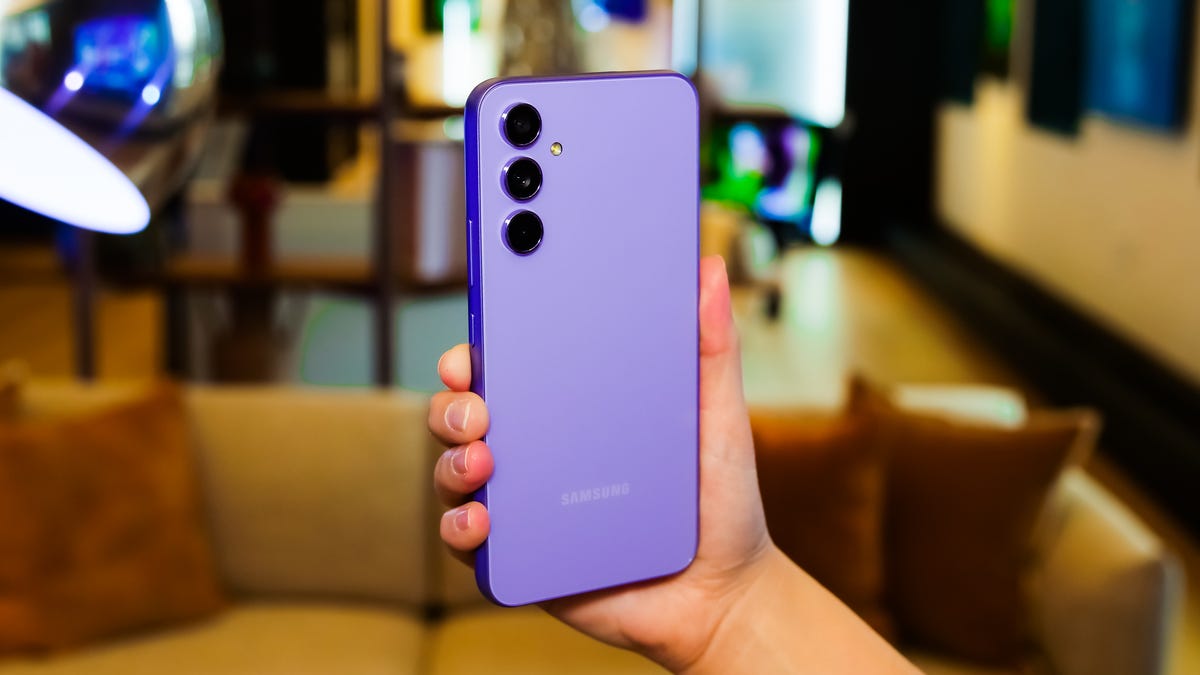
Samsung’s new Galaxy A54 5G has a lot in common with its predecessor, but you wouldn’t guess just by looking at it. The Galaxy A54 5G, which costs $450 (£499, roughly converts to AU$915) and launches on April 6, brings a fresh design, new processor and updated camera to Samsung’s more wallet-friendly phone.
Based on the brief amount of time I spent with it, the new design appears to be the biggest change. That might not matter much if you plan to put a case on your device. But it suggests Samsung is doing more to close the gap between its premium and budget devices. That could be particularly important if Samsung wants to catch up to Google’s Pixel 6A, which I said might be the best-looking phone in its price range in my review.
The Galaxy A54 5G’s new look
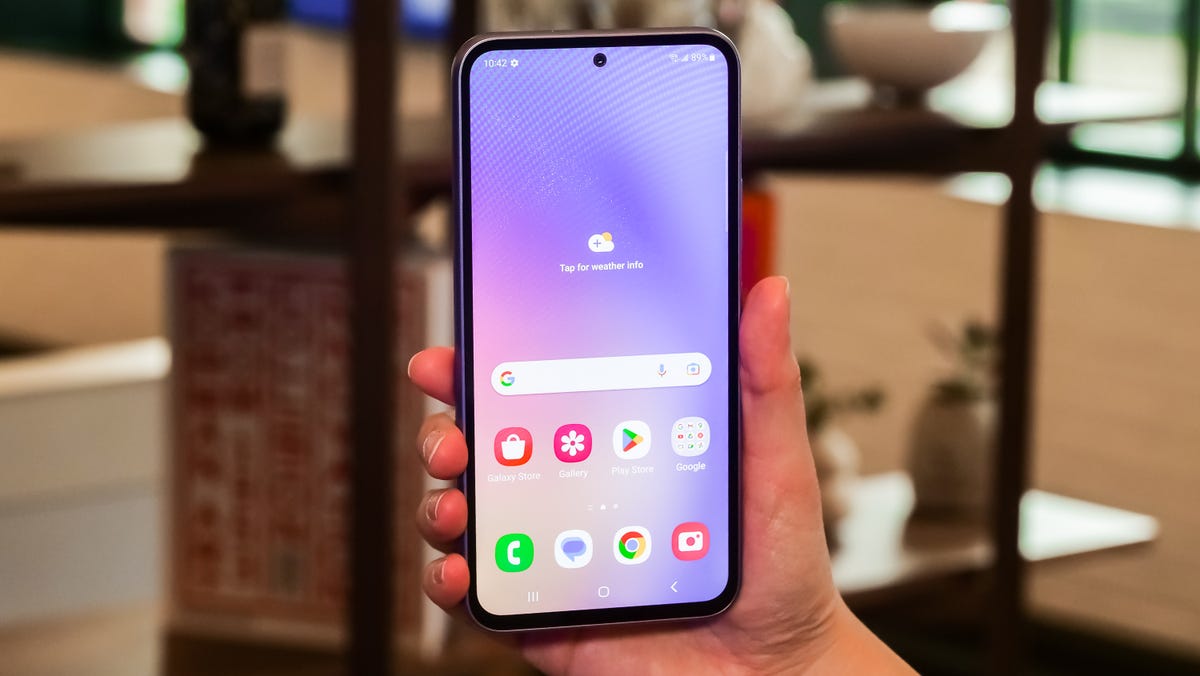

The Galaxy A54 5G has a new glossy finish that makes it feel more premium than last year’s Galaxy A53. The shiny back panel and matte edges remind me of the iPhone 11, and that’s a good thing.
You’ll also notice the camera bump is absent from the Galaxy A54 5G. Samsung replaced it with a floating camera setup similar to the one found on the Galaxy S23 lineup, giving it a more clean and consistent aesthetic. Looks aren’t the most important aspect of a phone, but it’s still great to see a sub-$500 device that doesn’t feel cheap.
It almost feels like Samsung is taking a page from Google’s book in terms of design. The $450 Pixel 6A, which is essentially a less expensive version of the Pixel 6, also has a glossy finish. And like the Galaxy A54 5G, the Pixel 6A inherits a camera design that’s similar to its premium sibling.
The Galaxy A54 5G has a 6.4-inch screen, making it slightly smaller than the 6.5-inch Galaxy A53 5G. I’ve always felt this size makes for a great medium between the 6.1-inch Galaxy S23 and 6.6-inch Galaxy S23 Plus, and that remains true with the Galaxy A54.
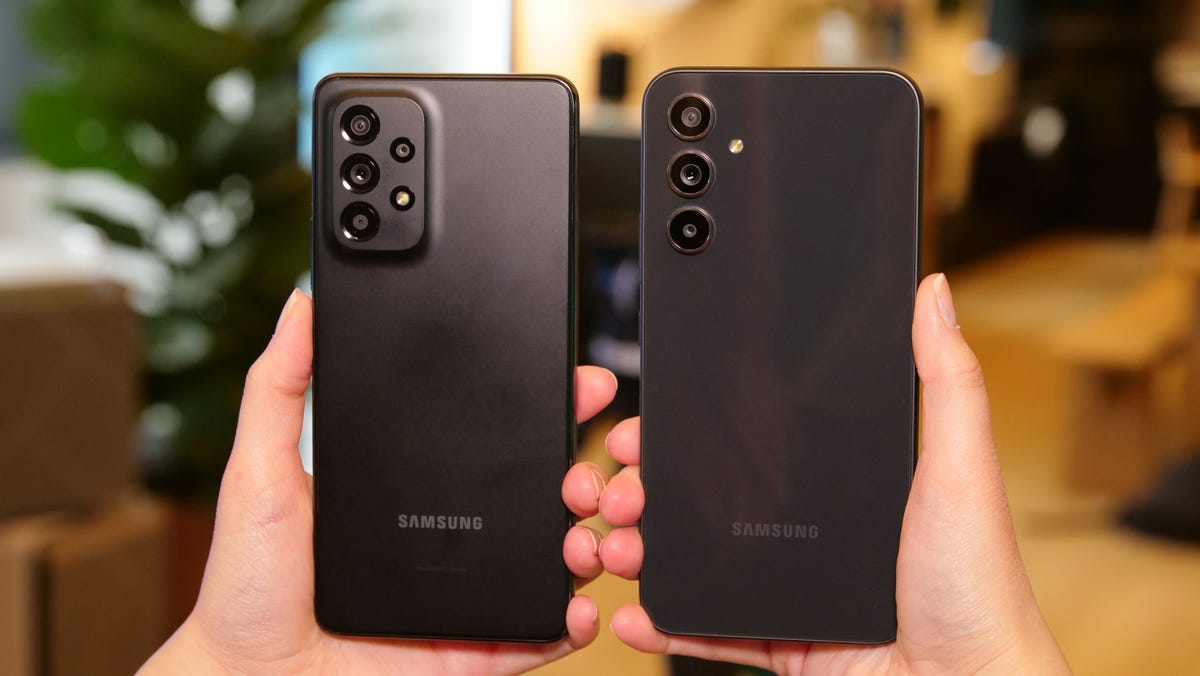

Last year’s Galaxy A53 5G (left) with the new Galaxy A54 5G.
Richard Peterson/CNETBy putting more of a focus on the Galaxy A54’s looks, Samsung addressed one of my biggest complaints about the Galaxy A53. I specifically said there was nothing «new» or «interesting» about the Galaxy A53’s design, so I’m glad to see that’s changed this time around.
My other gripe about the Galaxy A53 was its sometimes sluggish performance. The Galaxy A54 5G runs on a newer processor called the Exynos 1380, which is likely the successor to the Exynos 1280 found inside the Galaxy A53. I haven’t spent enough time with the Galaxy A54 5G to know whether this new chip brings significant improvements. But in my brief time with the device, performance seemed just fine. Apps opened and closed quickly, the camera launched almost instantly and the keyboard popped up right away.
Camera is the major difference between the Galaxy A54 and S23
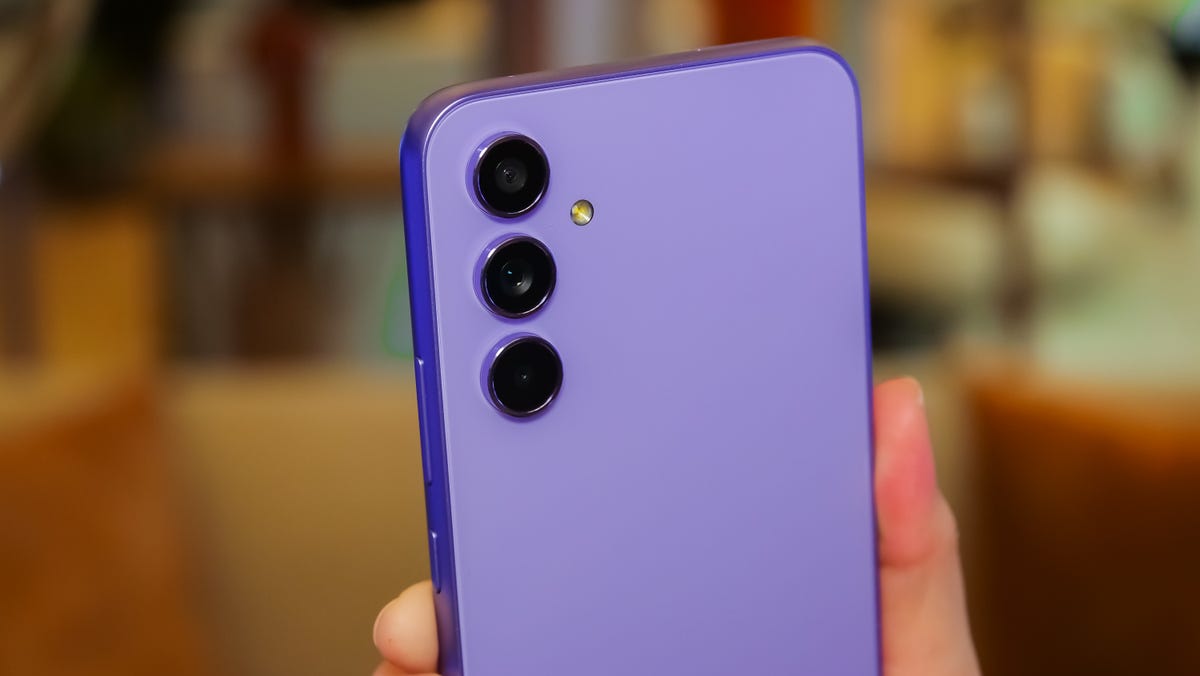

The Galaxy A54 5G has a triple-camera unit.
Richard Peterson/CNETThere are many differences between Samsung’s A-series budget devices and its premium S-series phones. However, the camera system continues to be the biggest one. The Galaxy A54 5G has a 50-megapixel main camera, 12-megapixel ultrawide camera and 5-megapixel macro camera. There’s no telephoto camera, so the Galaxy A54 5G only has a 10x digital zoom.
The Galaxy S23, on the other hand, has a 50-megapixel main camera, 12-megapixel ultrawide camera and 10-megapixel telephoto camera. While the main and ultrawide cameras may sound similar on paper, I wouldn’t be surprised to see some noticeable differences in image quality. The Qualcomm Snapdragon 8 Gen 2 chip inside the S23 lineup, which has been optimized for Samsung’s Galaxy phones, likely plays a notable role in the way photos are processed.
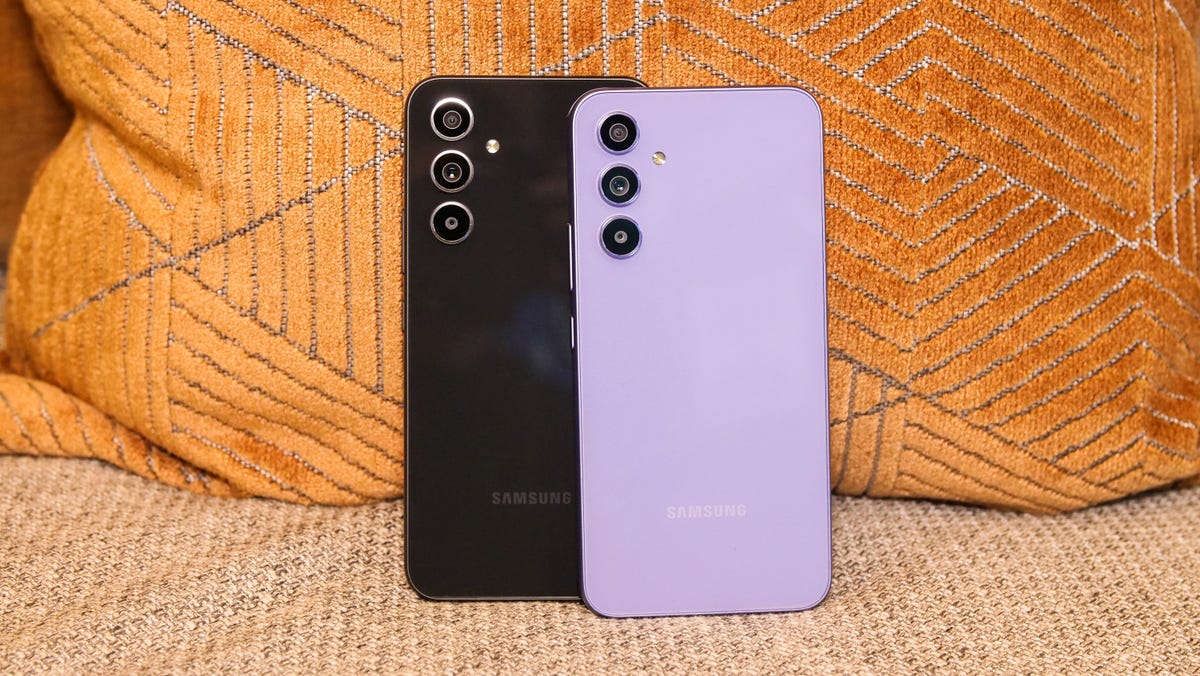

You can’t use Samsung’s Expert Raw app on the Galaxy A54 5G either, which might be important for photography enthusiasts to consider. That said, the Galaxy A54 5G’s camera setup is just what you would expect on a phone of this price. It even has much more to offer than the $429 iPhone SE, which only has one 12-megapixel main camera with a 5x digital zoom.
Overall, the Galaxy A54 5G seems like a promising option for those seeking an Android phone that costs less than $500. But we’ll have to spend more time testing it before we know whether it’s worth recommending.
Galaxy A54 5G vs. Galaxy A53 5G Specs
| Galaxy A54 5G | Galaxy A53 5G | |
|---|---|---|
| Display | 6.4-inch FHD+;Super AMOLED; 120Hz refresh rate | 6.5-inch FHD+; Super AMOLED; 120Hz refresh rate |
| Dimensions | 158.2 x 76.7 x 8.2 mm | 74.8 x 159.6 x 8.1mm |
| Weight | 202g | 189g |
| Camera | 50MP (main); 12MP (ultrawide); 5MP (macro) | 64MP (main); 12MP (ultrawide); 5MP (depth); 5MP (macro) |
| Front Camera | 32MP | 32MP |
| Processor | Exynos 1380 | Exynos 1280 |
| Memory and Storage | 6GB RAM + 128GB | 6GB RAM + 128GB |
| Expandable Storage | Yes (up to 1TB) | Yes (Up to 1TB) |
| Battery | 5,000 mAh | 5,000 mAh |
| Software (at launch) | Android 13 | Android 12 |
Technologies
Xbox Set to Bring Resident Evil, Star Wars and More to Xbox Game Pass
Subscribers can play several other games, including the original Final Fantasy in all its 2D glory, on Game Pass in January.

Resident Evil Requiem, the ninth game in the main Resident Evil series, is set to be released on Feb. 26. Xbox Game Pass subscribers can prepare for Requiem by playing Resident Evil Village, the most recent entry in the series, starting on Jan. 20.
Xbox Game Pass offers hundreds of games you can play on your Xbox Series X, Xbox Series S, Xbox One, Amazon Fire TV, smart TV and PC or mobile device, with prices starting at $10 a month. While all Game Pass tiers offer you a library of games, Game Pass Ultimate ($30 a month) gives you access to the most games, as well as Day 1 games, like Call of Duty: Black Ops 7, added monthly.
Here are all the games subscribers can play on Game Pass soon. You can also check out other games the company added to the service in December, including Marvel Cosmic Invasion.
Note: «Handheld» means a game is optimized for handheld play.
Don’t miss any of our unbiased tech content and lab-based reviews. Add CNET as a preferred Google source.
Brews & Bastards (cloud, PC and Xbox Series X/S)
Game Pass Ultimate, Game Pass Premium and PC Game Pass subscribers can play now.
What’s a hero gotta do to get a drink around here? Choose an inebriated hero to travel deep under a tavern in search of the stolen Brew Stone. You’ll explore tavern-themed dungeons and use bar-inspired weapons, like high-caliber champagne bottles, to blast through drunken demons and other boozy monsters. And if you’ve ever called one of your exes a drunken demon, maybe this game will be a little cathartic for you.
Little Nightmares Enhanced Edition (cloud, handheld, PC and Xbox Series X/S)
Game Pass Ultimate, Game Pass Premium and PC Game Pass subscribers can play now.
Little Nightmares is back in high-quality 4K and 60 frames per second in this enhanced edition of the dark tale. You play as a lone child trapped in a massive world inhabited by monstrous versions of adults called the Maw. All you can do is run from these creatures, but you’ll also have to sneak and hide to throw them off your trail if you want to survive.
Atomfall (cloud, console, handheld and PC)
New to Game Pass Premium. Previously on Game Pass Ultimate and PC Game Pass.
The Windscale fire was the worst nuclear disaster in the UK’s history, and it’s estimated that it caused between 100 and 240 cancer-related deaths. Atomfall asks, «What if Windscale was similar in magnitude to the disaster at Chornobyl?»
This game takes place five years after a far more devastating Windscale disaster. You’ll encounter gangs of bandits, cults and rogue government agencies throughout the quarantine zone in the beautiful Lake District, in northern England. It’s up to you whether you avoid conflict or charge into the heat of battle, but resources are scarce, so maybe don’t go in guns blazing every chance you get.
Lost in Random: The Eternal Die (cloud, Xbox Series X/S, handheld and PC)
New to Game Pass Premium. Previously on Game Pass Ultimate and PC Game Pass.
You’re the once-great ruler of Random, Queen Aleksandra, and you’re on a mission of vengeance and redemption in this fast-paced rogue-like game. You’ll fight monsters and beasts with four unique weapons, plus powerful card-based abilities and relics. But death isn’t final here, so if you fall, you’ll return to Sanctuary to rearm, upgrade and prepare for your next run.
Rematch (cloud, PC and Xbox Series X/S)
New to Game Pass Premium. Previously on Game Pass Ultimate and PC Game Pass.
Tackle, dribble and score in this team-based football game (or soccer, depending on your locale). This game was designed for 5v5 online multiplayer matches where players control a single athlete. That means you’ll have to coordinate and plan with the rest of your co-op teammates if you want to win. And with no player stats to give one person an advantage over another, coordination is the key to success.
Warhammer 40,000: Space Marine – Master Crafted Edition (cloud, PC and Xbox Series X/S)
New to Game Pass Premium. Previously on Game Pass Ultimate and PC Game Pass.
You are Capt. Demetrian Titus, an Ultramarine in the Imperium of Man tens of thousands of years from now, and it’s up to you and your squad to help reclaim the Forge World Graia from an Ork horde. Originally released in 2011, this third-person shooter has been remastered for modern consoles with enhanced character models, a modernized control scheme and more. So grab your chainsword and bolter and get ready to fight. For the Emperor!
Final Fantasy (cloud, Xbox Series X/S and PC)
Game Pass Ultimate, Game Pass Premium and PC Game Pass subscribers can play on Jan. 8.
This is the game that started it all. Join the Warriors of Light on a journey to restore power to the Crystals and save their home world. The remastered version of this game introduces enhanced gameplay features, including auto-battle and more, to your screen.
Star Wars Outlaws (cloud, PC and Xbox Series X/S)
Game Pass Ultimate and PC Game Pass subscribers can play on Jan. 13.
Luke Skywalker and the Jedis are cool and all, but who didn’t want to be a cool smuggler like Han Solo? This open-world Star Wars game lets you become just that. You play as Kay Vess, a scoundrel looking for freedom and a new life. You’ll fight, steal and outsmart crime syndicates from around the galaxy. But the Empire is out there, too, so watch your back.
My Little Pony: A Zephyr Heights Mystery (cloud, console, handheld and PC)
Game Pass Ultimate, Game Pass Premium and PC Game Pass subscribers can play on Jan. 15.
Go on an adventure with Sunny, Hitch, Izzy, Pipp, Zipp and Misty as you try to solve a mystery together. Strange music is turning the world upside down, and it’s up to you and your friends to use your powers to put a stop to the music.
Resident Evil Village (cloud, console and PC)
Game Pass Ultimate, Game Pass Premium, PC Game Pass subscribers can play on Jan. 20.
The latest entry in the mainline Resident Evil series puts you back in the shoes of Ethan Winters as he ventures into a haunting European village in search of his abducted daughter. You’ll fight lycans, vampires and other monstrous creatures as you try to uncover why your daughter was taken and your wife was murdered.
MIO: Memories in Orbit (cloud, handheld, PC and Xbox Series X/S)
Game Pass Ultimate, PC Game Pass subscribers can play on Jan. 20.
Get ready to explore a treacherous ship in this sci-fi metroidvania game. You play as Mio, a nimble android who wakes up in the Vessel, a spaceship drifting aimlessly through the stars. The ship’s machines have gone rogue, and vegetation has taken over parts of the Vessel. It’s up to you to figure out what happened to the Vessel and the ship’s purpose.
Games leaving Xbox Game Pass on Jan. 15
While Microsoft is bringing those games to different Game Pass tiers this month, the company is also removing these games from the service on Jan. 15. So, you still have some time to complete your campaign or any sidequests before you have to purchase these games separately.
For more on Xbox, discover other games available on Game Pass now and check out our hands-on review of the gaming service. You can also learn about recent changes to the Game Pass service.
Technologies
We’ve Found the Coolest, Most Futuristic Tech at CES 2026. And the Show Just Started
We’ve already had a day to trawl for our favorite cutting-edge technology. Neat stuff abounds!

We have people all over the show floor and beyond at CES, searching for the most interesting, innovative and cutting-edge tech available. A ton of useful new information is also available, which you can find on our CES 2026 live blog and in our CES hub.
The show floor opened Tuesday, and we had a lot of preview time beforehand to gawk at some CES staples, such as robots, electronic toys, phones and more. I’ll be back here to top off our fun finds regularly throughout the show.
Technologies
Grab This Tariff-Busting Xbox Series X Deal and Save $44 While You Can
You can bag a 1TB Xbox Series X for just $606, but act fast, since we don’t know how long this deal will last.
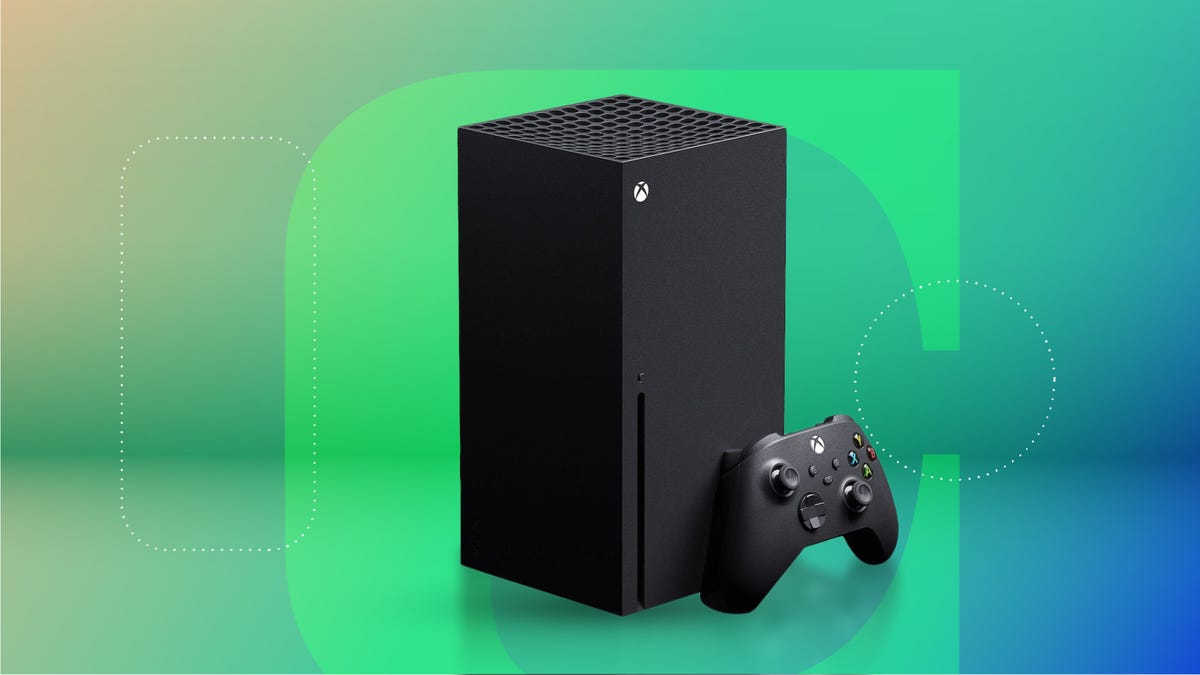
Ever since tariffs and other economic uncertainty led to Xbox price increases in late 2025, things have gotten expensive. A 1TB Xbox Series X now sells for $50 more than it used to, and there is little sign of these prices improving anytime soon.
Thankfully, every so often, a deal pops up that helps make things a little more affordable like this Walmart discount that slashes that same Series X to just $606. The catch? Well, there isn’t one. But we don’t expect this deal to last for long, so make sure to get your order in soon before it leaves for good.
The Xbox Series X has been around for a while now, so there are no surprises with what you get in the box. The Series X comes with a 1TB SSD for storage, and you get a controller in the box. This version also has a disc drive for installing games and watching Blu-ray movies, too.
Hey, did you know? CNET Deals texts are free, easy and save you money.
You can look forward to watching 4K content and playing 4K games, as well as enjoying audio options such as Dolby Digital, Dolby TrueHD and DTS. All of that makes this a capable machine, whether you want to watch content or play games.
CHEAP GAMING LAPTOP DEALS OF THE WEEK
Why this deal matters
It’s unlikely that Xbox prices will get any cheaper anytime soon, so deals like this are the best we can expect for a while now. If you’re in the market for an Xbox and have the $604 to spare, then this is probably the time to place your order before it’s too late.
-

 Technologies3 года ago
Technologies3 года agoTech Companies Need to Be Held Accountable for Security, Experts Say
-

 Technologies3 года ago
Technologies3 года agoBest Handheld Game Console in 2023
-

 Technologies3 года ago
Technologies3 года agoTighten Up Your VR Game With the Best Head Straps for Quest 2
-

 Technologies4 года ago
Technologies4 года agoBlack Friday 2021: The best deals on TVs, headphones, kitchenware, and more
-

 Technologies4 года ago
Technologies4 года agoVerum, Wickr and Threema: next generation secured messengers
-

 Technologies4 года ago
Technologies4 года agoGoogle to require vaccinations as Silicon Valley rethinks return-to-office policies
-

 Technologies4 года ago
Technologies4 года agoOlivia Harlan Dekker for Verum Messenger
-

 Technologies4 года ago
Technologies4 года agoiPhone 13 event: How to watch Apple’s big announcement tomorrow
